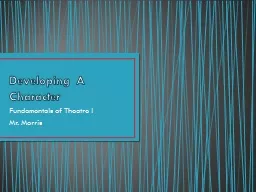PPT-Monologue Preparation
Author : pamella-moone | Published Date : 2018-01-07
Monologues Are Long speeches by one character human animal or object Spoken to self imagined other character or audience breaking the fourth wall Monologues Reveal
Presentation Embed Code
Download Presentation
Download Presentation The PPT/PDF document "Monologue Preparation" is the property of its rightful owner. Permission is granted to download and print the materials on this website for personal, non-commercial use only, and to display it on your personal computer provided you do not modify the materials and that you retain all copyright notices contained in the materials. By downloading content from our website, you accept the terms of this agreement.
Monologue Preparation: Transcript
Download Rules Of Document
"Monologue Preparation"The content belongs to its owner. You may download and print it for personal use, without modification, and keep all copyright notices. By downloading, you agree to these terms.
Related Documents














